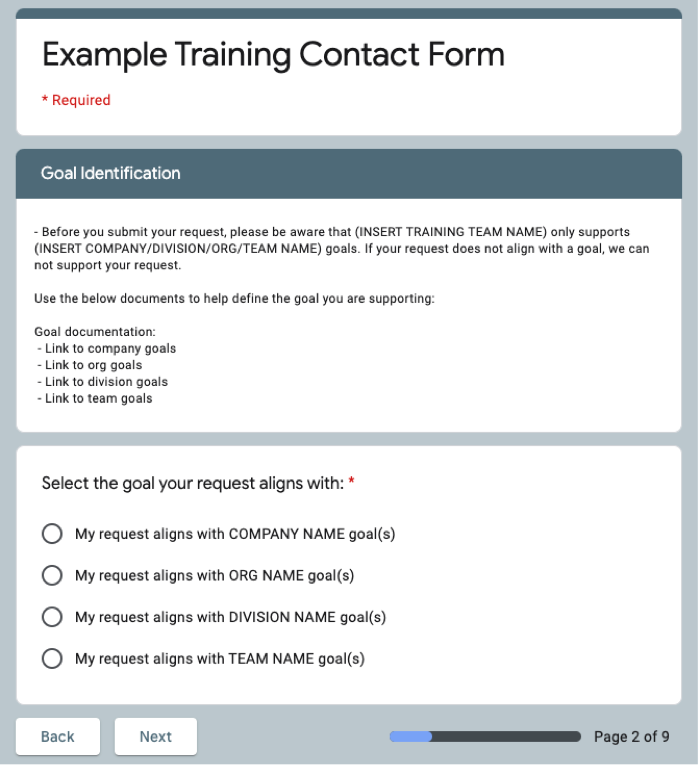Training is the method of choice for organizations attempting to upskill their workforce, increase employee knowledge, and create or improve behavior. The problem is, the vast majority of training does not lead to a lasting change in skills, knowledge, or behaviors of employees. The research on the topic suggests that only 10-22% of training events achieve learning transfer, the transfer of skills or knowledge gained in the training event to the employees’ role. Why is that? If learning transfer is the goal of all training events, why do so many training events fail to achieve this? This article will outline the key factors that influence learning transfer and provide you with a simple hack that will allow you to focus on the key training events that drive learning transfer.
What affects learning transfer?
There are three key factors that influence learning transfer.
- The organizational environment where employees spend most of their time
- Characteristics internal to the learner, such as their personality and goals
- The design of the training materials
Setting the stage for positive learning transfer requires alignment between the three factors.
As a learning professional, it can be difficult to influence the internal drives and characteristics of a learner. Likewise, it can be a challenge to make changes in the learner’s organizational environment without substantial support. However, learning professionals have an ace up their sleeve: complete control over the design and development of the training event and materials.
I know what you’re thinking: “Learning professionals have always designed the training event, but only 10-22% of training is successful?” Well, just as in a game of cards, having an ace up your sleeve is only an advantage when the conditions are right. So far, we’ve played like novice card players and pulled the ace out at every opportunity, hoping it will work. Sometimes it does, most of the time it doesn't. Without the right conditions, playing our ace card won't get us very far. But what if there was a way to game the system slightly to make the conditions such that playing our ace is more likely to result in successful learning transfer?
Gaming the system
There are several reasons why training fails. Lack of alignment with business goals is a key reason why training does not lead to learning transfer. We’ve all been there: the training on topic A is quickly forgotten by learners because their manager wants them to focus on goal B. There is no alignment between training and the business.
But what if we as learning professionals tweak our processes so that all the training requests we receive align with business needs, goals, and metrics? In this scenario, it's likely that learner participation and engagement will increase, and that managers will buy in and reinforce the behavior post-training because executive leadership are watching and want to see the needle move on those key initiatives. So now there are two of the three key factors for learning transfer in alignment: organizational factors and learner characteristics. But what about learning design? That's where you come in. The conditions are ideal; time to play the ace up your sleeve.
Hacking your training intake process
How do you tweak the system to make the environment ripe for learning transfer as in the example above? Chances are your learning department is inundated with requests to design and deliver all sorts of training. But how many of those requests are aligned with business goals? My guess would be very few. You are doing your company a disservice by committing your energy to creating training that is not aligned to the company goals. You are also wasting your time, as the training you create is, unfortunately, unlikely to lead to learning transfer without the right conditions.
L&D is a people-focused business and a lot of our training requests happen face-to-face. I get it—it's hard to say “no” to a request for training when you’ve said yes to these requests for so long.
You can hack this situation by creating a contact form through which you can funnel all your training requests. The very first question on the contact form should be, “What business goal is is your training request supporting?” Asking this question first will likely surprise the person requesting the training. They’ve probably never thought about this or have never been asked this question before.
Here’s a tip: Make the question mandatory to answer; don't make it optional. If requesters don't identify a business goal, they can't submit a training request. Sorry. Your time is precious, and you bring a lot of value for your employer, you don't have time to read training requests that don't move the needle on key business initiatives. Asking this question will allow you to be laser-focused on supporting your company to achieve its goals.
All companies have goals, and metrics aligned to those goals. They might be yearly, quarterly, monthly, or maybe even weekly goals. But they are there and they are published inside your company. Do your homework: find these goals and add them to your training request form with hyperlinks. After all, as a learning professional you still need to support training requesters, so make it easier for them by providing links to your company’s goals, mission, values, and other important documentation. See the example in Figure 1, created in Google Forms:

Figure 1: The Learning Transfer Hack Form
Once you have identified the business goal the training request is supporting, then you can ask your more traditional learning needs analysis questions, spurred on by the fact you are supporting your company to achieve its highest priorities.
Key takeaway
The goal of all training is to drive a change in performance post-training, that is, to achieve learning transfer. Use this Learning Transfer Hack to create a contact form to pinpoint the business goal that aligns with each training request so you can provide the biggest impact for the people, teams, and company you support.



